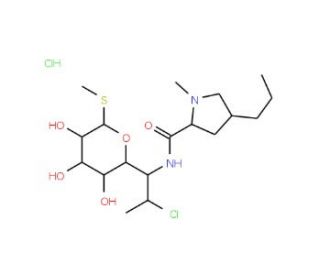

Clindamycin Hydrochloride Monohydrate (CAS 58207-19-5)
QUICK LINKS
Clindamycin Hydrochloride Monohydrate is a chemically stable form of clindamycin hydrochloride, a derivative of the antibiotic clindamycin, which is itself synthesized from lincomycin. This compound is characterized by a hydrochloride salt form, which increases its solubility in water, and a monohydrate aspect that refers to the presence of one molecule of water per molecule of clindamycin hydrochloride. In research contexts, Clindamycin Hydrochloride Monohydrate is primarily studied for its antibacterial properties, particularly its action against anaerobic bacteria and certain protozoans. Its mechanism of action involves inhibition of protein synthesis by binding to the 50S subunit of the bacterial ribosome, a feature that effectively halts the growth of bacteria by preventing the elongation of peptide chains. This specificity makes it an interesting subject in the study of ribosomal function and antibiotic resistance mechanisms. Researchers utilize this compound to investigate the dynamics of bacterial adaptation and resistance development, as well as to explore potential modifications that could enhance its efficacy or spectrum of activity. Additionally, its role in inducing changes in the microbiota provides a valuable tool for studies in microbial ecology and the interactions between bacterial communities and host organisms.
Clindamycin Hydrochloride Monohydrate (CAS 58207-19-5) References
- Clindamycin hydrochloride monohydrate and its ethanol solvate. | Ravikumar, K. and Sridhar, B. 2010. Acta Crystallogr C. 66: o97-100. PMID: 20124689
- Quantum mechanical studies of lincosamides. | Kulczycka-Mierzejewska, K., et al. 2012. J Mol Model. 18: 2727-40. PMID: 22116607
- Antibacterial Characterization of Novel Synthetic Thiazole Compounds against Methicillin-Resistant Staphylococcus pseudintermedius. | Mohammad, H., et al. 2015. PLoS One. 10: e0130385. PMID: 26086336
- Antibacterial Evaluation of Synthetic Thiazole Compounds In Vitro and In Vivo in a Methicillin-Resistant Staphylococcus aureus (MRSA) Skin Infection Mouse Model. | Mohammad, H., et al. 2015. PLoS One. 10: e0142321. PMID: 26536129
- Comprehensive identification of translation start sites by tetracycline-inhibited ribosome profiling. | Nakahigashi, K., et al. 2016. DNA Res. 23: 193-201. PMID: 27013550
- Bioavailability testing of a newly developed clindamycin oral suspension in a pediatric porcine model. | Goode, GA., et al. 2019. Pharm Dev Technol. 24: 1038-1043. PMID: 31134840
- Auranofin Rapidly Eradicates Methicillin-resistant Staphylococcus aureus (MRSA) in an Infected Pressure Ulcer Mouse Model. | Mohammad, H., et al. 2020. Sci Rep. 10: 7251. PMID: 32350417
- Clindamycin-Based 3D-Printed and Electrospun Coatings for Treatment of Implant-Related Infections. | Maver, T., et al. 2021. Materials (Basel). 14: PMID: 33802712
- Multidrug Resistance Plasmid pTZC1 Could Be Pooled among Cutibacterium Strains on the Skin Surface. | Koizumi, J., et al. 2023. Microbiol Spectr. 11: e0362822. PMID: 36847559
- Hybrid Polymer-Inorganic Materials with Hyaluronic Acid as Controlled Antibiotic Release Systems. | Lis, K., et al. 2023. Materials (Basel). 17: PMID: 38203913
Ordering Information
| Product Name | Catalog # | UNIT | Price | Qty | FAVORITES | |
Clindamycin Hydrochloride Monohydrate, 5 g | sc-294096 | 5 g | $148.00 | |||
Clindamycin Hydrochloride Monohydrate, 25 g | sc-294096A | 25 g | $452.00 | |||
Clindamycin Hydrochloride Monohydrate, 500 g | sc-294096B | 500 g | $5518.00 |
